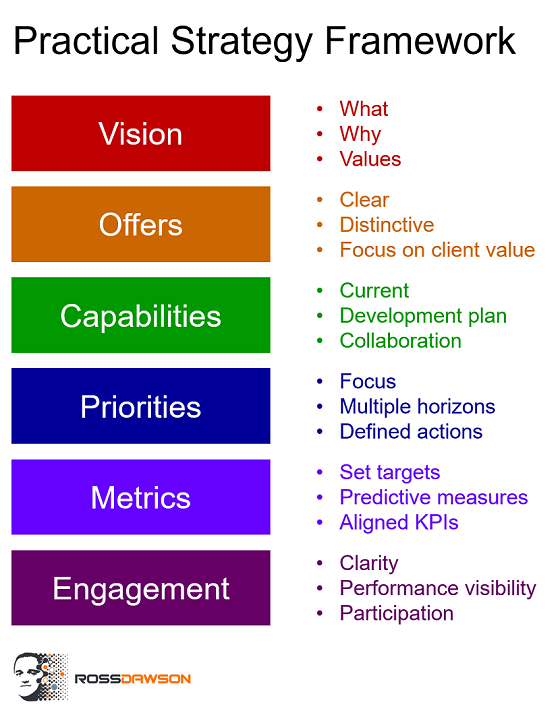A practical strategy framework to drive useful action and high performance
Last week I ran a three-day strategy workshop in Dubai for a group of senior executives who are marked as the next generation of leaders in a global professional services firm.
The heart of the workshop used scenario thinking to broaden their perspectives on change and strategic opportunity in their industry. We also wanted to provide a useful framework for the executives to develop and implement effective strategies for their respective country operations.
I was not able to find any strategy frameworks that were sufficiently relevant and pragmatic, so created a summary framework designed to be useful to any executives or entrepreneurs who need to develop practical, actionable strategies. I distilled the approaches and frames I have been successfully using for facilitating strategy development over the years with many executive groups, bringing it together into a succinct 6-step guide.
See below the diagram for a detailed explanation of the framework.

VISION
A vision describes where you are going, it is literally something you should be able to see in your mind’s eye. There are 7 characteristics of powerful visions, the most important of which are that they people see them as Compelling, Achievable and Clear.
In addition to describing evocatively where you intend to go, the vision should describe WHY the vision exists, the purpose behind it, and the values that support and shape the vision.
OFFERS
Every business must be clear on what they are offering their clients in terms of products, services, or outcomes. And they must be absolutely clear in what way those offers are distinctive in the marketplace, in terms of features, quality, price, positioning, brand or other defining characteristics.
In particular any good strategy must be framed on the distinctive value created for clients, from a genuine client perspective rather than the company’s perspective.
CAPABILITIES
Key to good strategy is clarity on the distinguishing capabilities of the organization that support the vision and how the company creates value for clients. It is critical to define what additional capabilities will need to be developed, and what is required to build these moving forward.
For almost all organizations collaboration is one of the most important factors underlying performance, both internal collaboration, and the ability to draw effectively on external capabilities and resources.
PRIORITIES
Any strategy of course needs to be crystallized into a clear, actionable plan that identifies the few top priorities that executives and managers need to focus on in addition to their everyday responsibilities. Each priority needs to be associated with defined actions, with clearly allocated responsibilities.
These priorities need to be set over multiple timeframes, giving clarity on what needs to be worked on over the longer-term, for example a three year timeframe, down to medium term and finally current and immediate priorities, often over a 3-6 month horizon to give clarity to efforts in the present.
METRICS
Executives need to know what to measure to see that they are on track to achieve their vision and objectives. These will certainly include absolute financial measurements, but should also include relevant business ratios, market performance and non-financial metrics, since no good vision is defined purely in financial terms. As importantly, metrics need to be established that give insight into the likely future performance of the organisation, for example indicators of innovation, employee motivation, or capability development.
From these metrics individual and team KPIs need to be designed that align personal activity and performance with the defined directions and intent of the organization.
ENGAGEMENT
A wonderful strategy will fail if it is not communicated effectively through the organization, resulting in a clear understanding of what needs to be done and broad-based engagement and buy-in. For this the strategy needs to be intelligible and able to be conveyed clearly and succinctly. Performance against defined strategic metrics should be visible across the company so people can see what progress is being made or how they need to adjust their efforts.
I personally believe that strategy should be participative, not simply something handed down from on high. Employees’ understanding of the company’s strategy and how its execution is performing enables them to contribute to strategy formation and feel fully engaged in the organization’s strategy.
There are many lenses through which to view strategy, as strategy doyen Henry Mintzberg beautiful describes. This strategy framework provides one perspective among many. What characterizes it is that it is designed to be as practical as possible for executives who are defining their path forward for the organization.
I hope you find the framework useful. Please let me know if you do.
Image: James Petts



